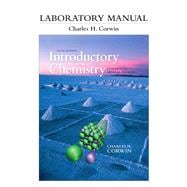
A. Instructor Demonstrations2 Instrumental Measurements
B. Student Experiments
A. Length Measurement3 Density of Liquids and Solids
B. Mass Measurement
C. Mass and Volume of an unknown solid
D. Volume Measurements
E. Temperature Measurements
A. Instructor Demonstration4 Freezing Points and Melting Points
B. Density of Water
C. Density of an Unknown Liquid
D. Density of a Rubber Stopper
E. Density of an Unknown Solid
F. Thickness of Aluminum Foil
A. Cooling Curve and Freezing Point5 Physical Properties and Chemical Properties
B. Melting Point of an Unknown
A. Physical Properties6 “Atomic Fingerprints”
B. Chemical Properties
A. Continuous Spectrum – White Light7 Families of Elements
B. Line Spectrum – Hydrogen
C. Line Spectra – Helium, Neon, Argon, Krypton, and Mercury
D. Identifying Unknown Elements in a Fluorescent Light
A. Analysis of Known Solutions8 Identifying Cations in Solution
B. Analysis of an Unknown Solution
A. Analysis of a Known Cation Solution9 Identifying Anions in Solution
B. Analysis of an Unknown Cation Solution
A. Analysis of a Known Anion Solution10 Analysis of a Penny
B. Analysis of an Unknown Anion Solution
A. Instructor Demonstrations-Combination Reactions11 Determination of Avogadro’s Number
B. Decomposition Reactions
C. Single-Replacement Reactions
D. Double-Replacement Reactions
E. Neutralization Reactions
F. Percentages of Copper and Zinc in a Penny
A. Calibrating a Dropper Pipet12 Empirical Formulas of Compounds
B. Calculating Molecules in the Monolayer
C. Determining Avogadro’s Number
A. Empirical Formula of Magnesium Oxide13 Analysis of Alum
B. Empirical Formula of Copper Sulfide
A. Percentage of Water in Alum Hydrate14 Decomposing Baking Soda
B. Percentage of Water in an Unknown Hydrate
C. Water of Crystallization in an Unknown Hydrate
A. Percent Yield of Na2CO3 from Baking Soda15 Precipitating Calcium Phosphate
B. Percentage of NaHCO3 in an Unknown Mixture
A. Percent Yield of Ca3(PO4)2 from CaCl216 Generating Hydrogen Gas
B. Percentage of CaCl2 in an Unknown Mixture
A. Molar Volume of Hydrogen Gas17 Generating Oxygen Gas
B. Atomic Mass of an Unknown Metal
A. Percentage of KClO3 in a Known Mixture18 Molecular Models and Chemical Bonds
B. Percentage of KClO3 in an Unknown Mixture
A. Molecular Models with Single Bonds19 Analysis of Saltwater
B. Molecular Models with Double Bonds
C. Molecular Models with Triple Bonds
D. Molecular Models with Two Double Bonds
E. Unknown Molecular Models
A. Solutes and Solvents20 Analysis of Vinegar
B. Rate of Dissolving
C. Demonstration of Supersaturation
D. Concentration of Sodium Chloride in Saltwater
A. Preparation of Standard Sodium Hydroxide Solution21 Electrical Conductivity of Aqueous Solutions
B. Concentration of Acetic Acid in Vinegar
A. Conductivity Testing—Evidence for Ions in Aqueous Solution22 Activity Series of Metals
B. Conductivity Testing—Evidence for a Chemical Reaction
C. Net Ionic Equations—A Study Assignment
A. Oxidation Numbers of Manganese23 Organic Models and Functional Groups
B. Oxidation Numbers of Chromium
C. Oxidation Numbers of Sulfur
D. Oxidation Numbers of Nitrogen
E. Oxidation–Reduction Equations
F. Activity Series and an Unknown Metal
A. Molecular Models of Hydrocarbons24 Separation of Food Colors and Amino Acids
B. Molecular Models of Hydrocarbon Derivatives
C. Unknown Molecular Models
A. Separation of Food Colors by Paper Chromatography25 Laboratory Instruments and Technique
B. Identification of Amino Acids by Paper Chromatography
A. Lab Practical ExamAPPENDICES
B. Lab Written Exam
A Laboratory Burner
B Decigram Balance
C CentigramBalance
D Milligram Balance
E Volumetric Pipet
F Activity Series for Metals
G Solubility Rules
H Laboratory Notebook
I Glossary
J Answers to Prelaboratory Assignments
The New copy of this book will include any supplemental materials advertised. Please check the title of the book to determine if it should include any access cards, study guides, lab manuals, CDs, etc.
The Used, Rental and eBook copies of this book are not guaranteed to include any supplemental materials. Typically, only the book itself is included. This is true even if the title states it includes any access cards, study guides, lab manuals, CDs, etc.